Recent Fire Damage Posts
Kitchen Safety: Kitchen Fires and Preventions - SERVPRO of St. Charles City
12/15/2024 (Permalink)
Kitchen Safety: Preventing and Responding to Kitchen Fires
The kitchen is the heart of the home, but it can also be a dangerous place if proper safety precautions aren’t followed. According to the National Fire Protection Association (NFPA), cooking is the leading cause of home fires and injuries. With a bit of knowledge and preparation, you can minimize the risk and ensure your kitchen remains a safe and enjoyable space. Here’s what you need to know about preventing and responding to kitchen fires.
Common Causes of Kitchen Fires
Unattended Cooking: The number one cause of kitchen fires is leaving food unattended on the stove or in the oven.
Grease Build-Up: Grease can accumulate on stovetops, range hoods, and nearby surfaces, increasing the risk of fire.
Flammable Items Near Heat: Towels, paper towels, oven mitts, and other flammable objects left near burners or other heat sources can easily ignite.
Faulty Appliances: Malfunctioning kitchen appliances or damaged electrical cords can spark fires.
Cooking While Distracted or Impaired: Multitasking or cooking under the influence of alcohol increases the likelihood of accidents.
Prevention Tips
Stay in the Kitchen: Never leave cooking food unattended. If you need to leave the room, turn off the burner or oven.
Keep Your Cooking Area Clear: Remove flammable objects from the stovetop and surrounding area.
Monitor Grease Levels: Clean stovetops, range hoods, and nearby surfaces regularly to prevent grease build-up.
Install and Maintain Smoke Detectors: Place smoke detectors near the kitchen (but not directly inside to avoid false alarms). Test them monthly and replace batteries annually.
Use Proper Equipment: Use a lid or splatter guard when cooking with oil to prevent splashes. Keep a fire extinguisher rated for kitchen use (Class B or multipurpose) within easy reach.
Practice Safe Cooking Techniques: Avoid wearing loose clothing that could catch fire. Turn pot handles inward to prevent accidental spills.
Inspect Appliances: Regularly check cords and plugs for wear and tear, and replace or repair damaged appliances promptly.
How to Respond to Kitchen Fires
Even with precautions, accidents can happen. Knowing how to respond quickly and effectively can prevent a small fire from escalating into a dangerous situation.
Grease Fires
DO NOT Use Water: Water can cause grease fires to spread. Instead, smother the fire by sliding a metal lid or baking sheet over the pan.
Turn Off the Heat: Immediately turn off the burner to stop feeding the fire.
Use Baking Soda: If the fire is small and contained, you can use baking soda to extinguish it. Avoid using flour or other powders as they can ignite.
Use a Fire Extinguisher: If the fire grows, use a Class B or multipurpose extinguisher.
Oven or Microwave Fires
Close the Door: Keep the oven or microwave door closed to cut off the fire’s oxygen supply.
Turn Off the Appliance: Unplug the appliance if it’s safe to do so.
Call 911: If the fire doesn’t go out quickly, evacuate and call emergency services.
When to Call for Help
If a fire becomes unmanageable or spreads, evacuate the home immediately and call 911. Never try to fight a fire that is too large or producing thick smoke. Your safety is the top priority.
Create a Kitchen Fire Safety Plan
Plan Your Escape: Make sure all household members know how to safely evacuate in case of a fire.
Practice Fire Drills: Regularly practice fire drills to ensure everyone knows what to do in an emergency.
Teach Children About Fire Safety: Educate kids on the dangers of playing near stoves and how to respond to emergencies.
What to do if you have any fire damage:
Call SERVPRO of St. Charles City. It is our job to ensure that your home is taken care of and repaired correctly. We would be happy to come in at any time to help you and your family out if you encounter any fire damage. We are available 24/7, 365 days a year.
A Comprehensive Approach to Fire Damage Restoration | SERVPRO of St. Charles
5/29/2024 (Permalink)
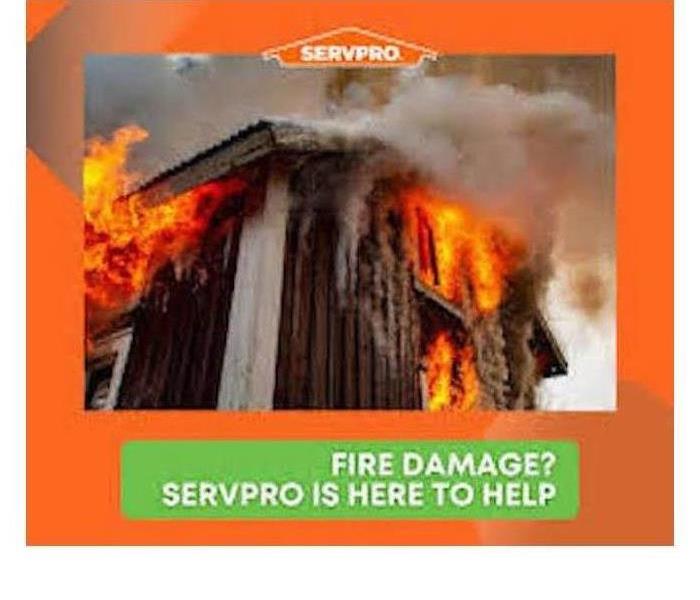 Trust SERVPRO of St. Charles' comprehensive approach to fire damage restoration
Trust SERVPRO of St. Charles' comprehensive approach to fire damage restoration
In the wake of a fire damage event, the physical devastation left behind can be overwhelming. SERVPRO of St. Charles is here to help answer all of your concerns, rebuilding lives and restoring homes and businesses. With a diligent approach grounded in expertise and empathy, SERVPRO of St. Charles goes above and beyond to bring comfort and renewal to those affected by fire damage.
Understanding the Impact
Before diving into the fire damage restoration process, we recognize the profound impact that fire damage can have on individuals, families and businesses. It's not just about repairing structures; it's about healing hearts and minds. Thus, the first step is always to empathetically assess the situation, listening to the concerns and needs of the clients with compassion and understanding.
Swift Response and Assessment
Time is of the essence in fire damage restoration. With every passing moment, the damage can escalate, making restoration more challenging and costly. We understand this urgency and operate with efficiency and speed. Upon receiving a call for assistance, our team swiftly mobilizes, arriving at the site promptly to assess the extent of the damage. Utilizing advanced technology and years of expertise, we conduct a thorough evaluation, identifying not only visible damage but also potential hidden issues such as water damage from firefighting efforts or structural compromise.
Tailored Restoration Plan
Once the assessment is complete, a customized restoration plan tailored to the specific needs of the property and its occupants. This plan outlines the steps necessary to mitigate damage, salvage belongings, and restore the property to its pre-fire condition. Transparency is key, and clients are kept informed at every stage of the process, ensuring peace of mind amidst the chaos.
Comprehensive Cleanup and Restoration
With a clear plan in place, SERVPRO of St. Charles' team gets to work, employing state-of-the-art equipment and industry-best practices to execute the restoration process meticulously. From removing debris and soot to addressing water damage as well as smoke and odor removal, no detail is overlooked. Every surface is cleaned, every corner inspected, and every effort made to ensure thorough restoration.
Salvaging Belongings
One of the most heartbreaking aspects of fire damage is the loss of cherished belongings. Recognizing the sentimental value attached to these items, we employ specialized techniques and equipment to salvage and restore as much as we possibly can. Whether it's family heirlooms, photographs, or important documents, our team works tirelessly to bring these items back to life.
Reconstruction and Renovation
Once the cleanup and salvage efforts are complete, the focus shifts to reconstruction and renovation. Whether it's repairing structural damage, replacing flooring and drywall, or rebuilding entire sections of the property, our skilled employees approach each task with precision and care. The goal is not just to rebuild the physical structure but to restore a sense of normalcy and security to the lives of those affected.
Constant Communication and Support
Throughout the entire restoration process, SERVPRO of St. Charles maintains open lines of communication with clients, providing regular updates on progress and addressing any concerns or questions that may arise. Our team understands the emotional toll of fire damage and strives to provide not just exceptional service, but genuine support and reassurance every step of the way.
Going Above and Beyond
What sets us apart is our unwavering commitment to excellence and our dedication to going above and beyond for our clients. From our rapid response times to our meticulous attention to detail, every aspect of our service is infused with a sense of compassion and professionalism.
The Do's And Don'ts of Fire Damage Restoration | SERVPRO of St. Charles
9/27/2023 (Permalink)
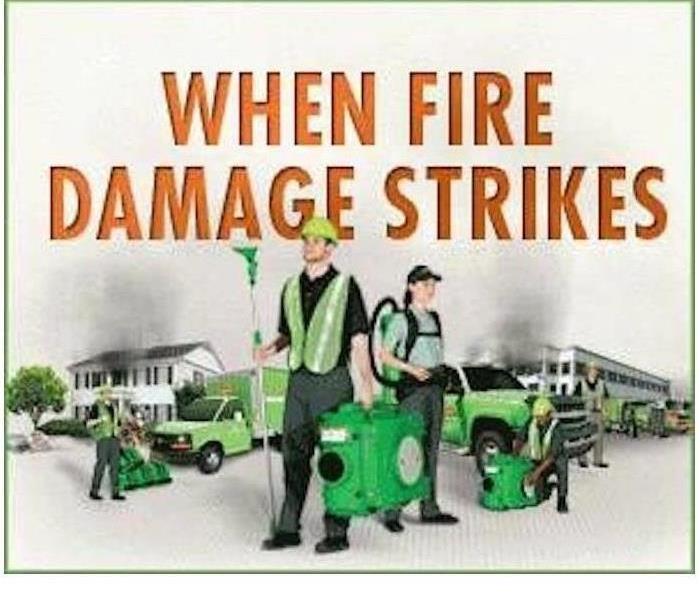 SERVPRO of St. Charles is your trusted choice for fire damage restoration
SERVPRO of St. Charles is your trusted choice for fire damage restoration
Fire damage in your home or business is a devastating event that leaves behind not only physical destruction but also emotional turmoil.
When the flames are extinguished, and the smoke clears, the path to recovery begins with fire damage restoration. In this extensive guide, we will delve into the do's and don'ts of fire damage repair and restoration. Whether you're dealing with fire damage, smoke damage, soot cleanup, or smoke odor removal, this comprehensive resource will equip you with the knowledge to make informed decisions and protect your St. Charles, MO property.
The Do's of Fire Damage Restoration
1. Do Contact Professionals Immediately: As soon as the fire is extinguished and authorities declare it safe to enter the premises, reach out to a reputable fire damage restoration company like SERVPRO of St. Charles. Swift action can mitigate further damage and reduce restoration costs.
2. Do Prioritize Safety: Safety should always be your top concern. Do not enter the fire-damaged property until authorities confirm it's safe. Once inside, exercise caution due to potential structural instability, electrical hazards, and toxic soot and smoke residue.
3. Do Document the Damage: Take photographs and videos of the fire damage for insurance purposes. Visual evidence is invaluable and can expedite the claims process, ensuring you receive the compensation you deserve.
4. Do Secure the Property: If authorities allow you to enter, secure the property to prevent unauthorized access, potential theft, or vandalism.
5. Do Notify Your Insurance Company: Notify your insurance company promptly to initiate the claims process. SERVPRO of St. Charles can collaborate directly with your insurance provider to streamline the restoration process.
6. Do Address Water Damage: Firefighting efforts often lead to water damage. It's crucial to address this issue promptly to prevent mold growth and further structural damage.
7. Do Allow Professionals to Assess Smoke Damage: Smoke and soot can cause extensive damage beyond what's visible. Allow professionals like SERVPRO of St. Charles to assess the full extent of the smoke damage and develop a comprehensive restoration plan.
8. Do Secure Temporary Shelter: If your home is uninhabitable, secure temporary shelter for yourself and your family. Your safety and well-being should remain a top priority throughout the restoration process.
The Don'ts of Fire Damage Restoration
1. Don't Attempt DIY Cleanup: Fire damage restoration is a complex process requiring specialized knowledge and equipment. Attempting do it yourself cleanup can exacerbate the damage and pose safety risks.
2. Don't Discard Valuables Prematurely: Avoid disposing of damaged items without consulting professionals. SERVPRO of St. Charles' fire damage restoration services emphasize content cleaning and restoration, potentially salvaging items you thought were lost.
3. Don't Overlook Smoke Odor: Smoke odor can persist long after the fire is extinguished. Neglecting smoke odor removal can compromise indoor air quality and your comfort in the restored space.
4. Don't Delay Restoration: Time is of the essence in fire damage restoration. Delaying the process can lead to further damage, increased restoration costs, and potential health hazards due to mold and soot exposure.
5. Don't Skip Professional Assessment: Even if visible damage appears minimal, do not skip a professional assessment. Smoke and soot can infiltrate hidden spaces, jeopardizing the structural integrity of your property.
6. Don't Assume Items Are Unsalvageable: Fire-damaged belongings may appear beyond repair, but professional restoration experts have the knowledge and techniques to salvage many items, including sentimental possessions.
Why Choose SERVPRO of St. Charles for Fire Damage Restoration
SERVPRO of St. Charles is the undisputed choice for fire damage restoration for a multitude of reasons, including:
Experience and Expertise: With years of experience, SERVPRO of St. Charles' technicians are highly trained in fire damage restoration, smoke odor removal, soot cleanup, and more.
Advanced Equipment: SERVPRO employs state-of-the-art equipment and techniques for a thorough and efficient restoration process.
Comprehensive Services: From water damage mitigation to content cleaning and restoration, SERVPRO offers a complete range of fire damage restoration services.
24/7 Emergency Response: Fires can occur at any time. SERVPRO of St. Charles provides round-the-clock emergency response to address your immediate needs.
Insurance Collaboration: SERVPRO works closely with insurance companies to expedite claims processing, easing the burden on you during this challenging time.
Community Commitment: SERVPRO of St. Charles is not just a restoration company; it is a part of the St. Charles, Missouri community. They understand the unique needs of local residents and businesses.
Reputation for Excellence: SERVPRO of St. Charles has built a strong reputation for delivering exceptional service and results. Their commitment to customer satisfaction sets them apart.
The Road to Recovery
While fire damage can be emotionally and physically devastating, it's essential to remember that recovery is possible. With the right professionals by your side, your property can be restored to its pre-fire condition, and your life can regain a sense of normalcy.
Assessment and Planning: The fire damage restoration process typically begins with a comprehensive assessment of the damage and the development of a restoration plan. SERVPRO of St. Charles' experts will work closely with you to ensure your needs are met.
Content Cleaning and Restoration: Professional restoration companies like SERVPRO of St. Charles have advanced techniques for cleaning and restoring your belongings. Many items you thought were lost can be salvaged.
Structural Repairs: Extensive structural damage may require repairs and reconstruction. Experienced restoration teams can handle everything from minor repairs to major renovations.
Smoke Odor Removal: Smoke odor can linger long after the fire is extinguished. SERVPRO of St. Charles employs specialized techniques and equipment to eliminate smoke odors, ensuring your space is comfortable and odor-free.
Thorough Cleaning: Every surface affected by fire and smoke damage will be meticulously cleaned to remove soot and residues. This includes walls, ceilings, floors, and personal belongings.
Restoring Indoor Air Quality: High-efficiency particulate air (HEPA) filtration systems and air scrubbers may be used to improve indoor air quality, removing particles and odors caused by the fire.
Rebuilding and Reconstruction: Once the restoration is complete, SERVPRO of St. Charles can handle any necessary reconstruction to return your property to its pre-fire condition.
Preventing Future Fire Damage
After successfully restoring your property from fire damage, it's imperative to implement preventive measures to reduce the risk of future fires. Here are some strategies to maintain a fire-resistant environment:
Install Smoke Alarms: Ensure smoke alarms are installed on every level of your property and test them regularly.
Fire Extinguishers: Have fire extinguishers readily accessible in key areas, and educate occupants on their use.
Electrical Safety: Regularly inspect electrical systems for faults or signs of wear. Avoid overloading circuits and ensure safe usage of extension cords.
Kitchen Safety: Exercise caution when cooking, and never leave cooking unattended. Keep flammable items away from stovetops.
Proper Storage: Store flammable materials, chemicals, and fuels in safe, designated areas away from potential ignition sources.
Chimney and Fireplace Maintenance: If you have a fireplace or wood-burning stove, ensure they are properly maintained and cleaned regularly.
Moving Forward with Confidence
Once the fire damage restoration process is complete and your property is returned to its pre-fire condition, it's time to move forward with confidence. While the experience may have been harrowing, it can also serve as a catalyst for positive change. Here are some ways to embrace a brighter future:
Fire Safety Education: Use your experience as an opportunity to educate yourself and others about fire safety. Share your knowledge with friends, family, and neighbors to prevent future incidents.
Emergency Preparedness: Develop an emergency plan for your family or business, including evacuation routes, communication strategies, and emergency contacts.
Community Involvement: Consider becoming involved in community organizations or activities related to fire safety and recovery support. Your experience can be a valuable asset to others facing similar challenges.
Conclusion
While the aftermath of a fire can be emotionally and physically overwhelming, it's essential to remember that recovery is possible. The dos and don'ts of fire damage restoration provide a roadmap to navigate this challenging journey, and choosing the right professionals like SERVPRO of St. Charles can make all the difference.
SERVPRO of St. Charles not only possesses the experience, expertise, and state-of-the-art equipment needed for effective fire damage restoration but also understands the emotional toll such events can take on individuals and communities. Their commitment to customer satisfaction, collaboration with insurance companies, and dedication to community involvement make them the preferred choice for fire restoration services.
SERVPRO of St. Charles is here to help with your fire damage restoration needs. We have 24/7 emergency services and are always available when you need us. Call us any time at (636) 926-0033.
5 Winter Home Heating Safety Tips
1/17/2023 (Permalink)
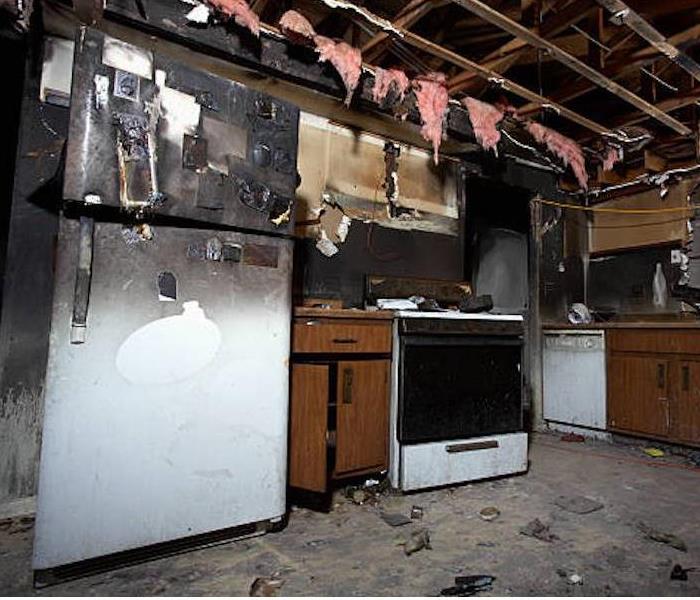 Preventative measures can help avoid a winter fire.
Preventative measures can help avoid a winter fire.
1. Be Aware of Flammable Materials
Keep anything that burns easily at least three feet away from fireplaces, wood stoves, furnaces and space heaters. Fires often spread past its origin point because the heat source was too close to something flammable. Make sure nothing is close to your heat sources to prevent a fire from spreading.
2. Service Your Heating System Annually
Hiring a professional to inspect and clean your heating system and chimneys can help ensure your safety. These checks should be done annually. You should also be active in checking the areas around the furnace and boiler.
3. Don’t Leave Space Heaters Unattended
25,000 house fires and more than 300 deaths are caused each year by space heaters. Never keep space heaters on when no one is around or while you are sleeping. Space heaters should be plugged directly into a wall, as extension cords or power strips can overheat and cause a fire.
4. Test Smoke and Carbon Monoxide Detectors Monthly
According to a study by the federal Centers for Disease Control and Prevention, the first month of the year is the worst for carbon monoxide poisoning. House fires are also common after the holidays. It’s extremely important to regularly check that all your detectors have working batteries.
5. Fireplace Safety
Keep a screen over your fireplace to stop sparks from flying out. Let fire ashes cool before putting them into any covered, metal container. Also, ashes should never be kept in plastic containers. Keep all containers of ashes a safe distance away from your home.
Winter Weather Hazards
1/3/2023 (Permalink)
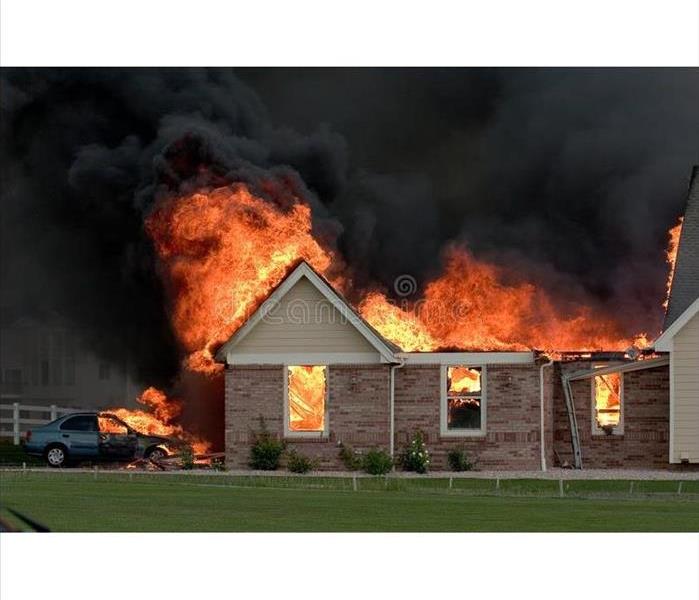 Winter fires generally take place in the kitchen or from heating systems.
Winter fires generally take place in the kitchen or from heating systems.
Winter weather leads to issues for thousands of people and their homes each year. Since cold weather can cause issues that don’t occur the rest of the year, it’s important to be vigilant about any problem that could arise.
Here are some potential problems that should be on your radar this winter.
1. Heating System Fire
While most winter fires take place in the kitchen, heating systems can also be a culprit. Thousands of residential fires occur each year due to failure of home heating systems. Fireplaces, chimneys and chimney connectors are responsible for half of the fires. That’s why it’s important to have your heating system checked regularly, especially if you have a gas or electric furnace or heat pump.
Space heaters also cause many fires in the winter, and in total cause 25,000 per year. Space heaters should never be left on unattended, especially after going to sleep.
Being aware of the potential hazards of your heating system can keep you fire-free this winter.
2. Frozen Pipes
Pipes freezing and bursting can be a nightmare for your home.
Frozen pipes cause an estimated $400-$500 million in damage annually. To avoid adding to that number, it’s crucial to take preventive measures. Drain water from pipes that are likely to freeze and disconnect any outside hoses.
If you are still worried that your pipes might freeze, you can also place a 60-watt bulb in areas you’re concerned with. Just make sure none of the materials near the bulb are combustible.
To keep pipes from freezing, your thermostat should be kept around the same temperature at all times, and your house temperature should never fall below 55 degrees.
3. Ice Dams
While ice dams can be pretty to look at, they can be a nuisance to deal with. Since ice dams are caused by a lack of uniform roof surface temperatures, this problem must be addressed if you are experiencing ice dams. Making your ceiling and attic air-tight, adding insulation and installing heating cables to the roof are all steps that can create uniform temperatures.
If you are already dealing with ice dams, you can take a long-handled aluminum roof rake to scrape off snow from the roof. And if you’re experiencing leaking, you can set up a box fan in the attic and aim it at the bottom of the roof where water is leaking in. This will freeze the water and stop the leak.
4. Carbon Monoxide
Cold temperatures can often lead to problems with carbon monoxide in the home. Sadly, 430 people die annually from carbon monoxide poisoning, while approximately 50,000 are hospitalized.
Carbon monoxide poisoning occurs due to faulty heating systems. Whether it’s unvented space heaters, malfunctioning furnaces, clogged chimneys or other heating system issues, it’s important to make sure your system is functioning properly.
That’s why you should have your furnace and fireplace inspected before each winter. In addition, carbon monoxide detectors should be installed in your home (if you don’t already have them), and the batteries should be checked and replaced regularly.
Also, make sure that if you’re going to use space heaters they are properly ventilated.
We Are Ready if Fire Damage Strikes
7/21/2022 (Permalink)
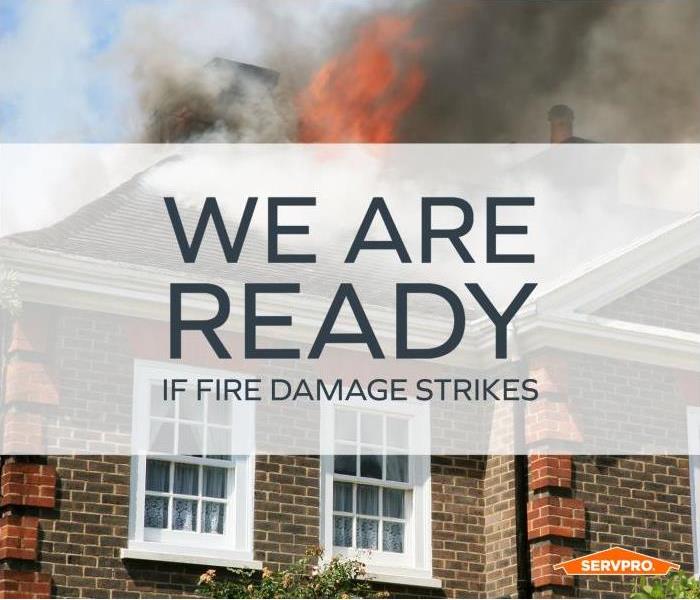 Our team is ready to serve businesses and families in the greater St. Charles area.
Our team is ready to serve businesses and families in the greater St. Charles area.
While cases where fire consumes an entire home in St. Charles, MO happen, there are many times in which the fire damage is minor. However, soot and smoke can damage the entire home, making even a small fire a disaster. You may feel hopeless and without options, but that’s not the case.
Involving a professional is the best way to reduce costs and prevent secondary damage. Depending on the type of fire, and the way it is fueled, may require different techniques. SERVPRO of St. Charles is IICRC certified and has the experience to tackle difficult problems. The level and type of damage will likely require a unique response.
Minor damages typically involve mostly smoke residue damage. The deposits are light to moderate, and restoration mostly involves a deep cleaning of the affected surfaces and fabrics. There are different techniques that are technicians use to remove the smoke odor and residue from your home. In this type, almost all the cleaning would be done onsite.
In more moderate damage situations, there will be smoke and heat damage on different surfaces. Your cabinets, drywall, and contents may have heat damage. Odors will likely be stronger at this damage degree as well. Our technicians will use varying techniques to remove items that are heavily damaged and determine what can be cleaned or will need to be replaced.
In majorly fire damaged homes, there is more severe heat damage throughout the home. Usually this is close to where the fire started, but this can leave parts of the structures framing charred. This often involves making structural repairs and gutting the heavily damaged parts of the home. Smoke damage is often heavy throughout. This requires extensive cleanup and removal of debris from the structure. Content cleaning for majorly damaged homes will need to be completed offsite.
Each fire damage situation is unique, and the process may vary depending on our customers' needs. We will explain the restoration process that is unique to your home upon onsite inspection. We are happy to answer any questions and make the process as stress free as possible.
We also provide board up services to help protect your home from additional damage during extended repair.
As soon as the fire trucks leave, give SERVPRO of St. Charles City a call. We will arrive onsite and help determine what your next step will be to reduce damage and work with your insurance company.
Our team is trained to address small and large fire damage projects. Our team is ready to serve businesses and families in the greater St. Charles area including St. Peters, O’Fallon, Weldon Spring, and Portage Des Sioux.
Call us and let us help you, (636) 926-0033
Restoration After a Grease Fire
6/2/2022 (Permalink)
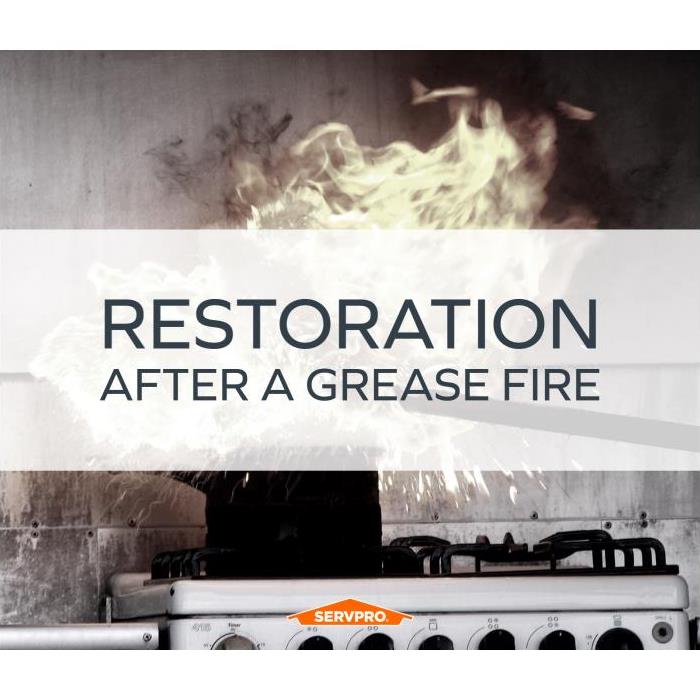 SERVPRO of St. Charles City fire damage restoration specialists have all the tools and training needed for every size disaster.
SERVPRO of St. Charles City fire damage restoration specialists have all the tools and training needed for every size disaster.
Cooking is one of the most common causes of a kitchen fire. Did you know that the highest risk comes from frying foods? A grease fire in your greater St. Charles area home is dangerous.
These types of fire can get out of control quickly. Prevention is critical when it comes fires, so here are some helpful tips to remember when your cooking:
- Always use a clean surface. Clean up any spills on your cooktop once it cools. Greasy exhaust hoods or stovetops can catch fire quickly.
- Never leave food unattended. It can take just minutes for cookware to scorch or boil over.
- Always keep a lid within reach and a fire extinguisher nearby.
When you experience a kitchen fire, there are bound to be strong odors even if the fire was relatively small. SERVPRO of St. Charles City is always available 24/7 when you need help handling the cleanup after a grease fire or any blaze within your home or business. We make it “Like it never even happened.”
A kitchen fire can be intimidating, but we are here for prompt emergency fire restoration service. Give us a call today, (636) 926-0033.
Why Is My Smoke Alarm Beeping?
5/20/2022 (Permalink)
 Don’t risk it – protect yourself and your family by promptly investigating – and if needed, replacing your smoke detectors.
Don’t risk it – protect yourself and your family by promptly investigating – and if needed, replacing your smoke detectors.
We all know by now that having a working smoke detector is critical when it comes to home safety. A properly functioning smoke detector can alert you to danger and help save lives.
Sometimes smoke alarms sometimes can make a loud obnoxious chirp noise – even though there is no smoke. Why is it being so – let’s face it – annoying?
Perhaps time flew by, and you forgot to change the batteries. Maybe it is a loose battery, or the terminal is obstructed. Open your smoke detector and if all looks well put a new battery inside. Use the self-check button on your alarm to ensure everything is functioning after installing or resetting the batteries.
- Checking your batteries once a month is recommended.
- Change your batteries once a year if they are replaceable.
- If you have a non-replaceable 10-year battery smoke detector, replace it as soon as possible when it starts chirping.
Another reason your smoke alarm may chirp is due to a dirty sensing chamber. Routinely dusting your alarm can help with this issue.
If you have a wired smoke detector with battery backup, and replacing the battery didn’t help, you should inspect each detector wiring for loose connections. If you notice lights dimming, especially when an appliance is in use, contact an electrician.
After checking over your smoke alarm, your smoke detector is still beeping? It might be the end of its lifespan. Did you know that smoke alarms typically last about 8-10 years? After this period, the units sensing capacity may diminish, reducing its effectiveness. It may simply be time to replace your smoke detectors.
While a fire alarm may not spare your home from a destructive fire or smoke damage, this device may save your life. Don’t risk it – protect yourself and your family by promptly investigating – and if needed, replacing your smoke detectors.
If your home experience smoke or fire damage, our team at SERVPRO of St. Charles City are ready to help restore your property to preloss condition.
Our team is trained to address small and large fire damage projects. We are IICRC certified and have the experience to tackle difficult problems. Our team is ready to serve businesses and families in the greater St. Charles area including St. Peters, O’Fallon, Weldon Spring, and Portage Des Sioux.
Call us and let us help you, (636) 926-0033.
What to Do After A Fire
3/24/2022 (Permalink)
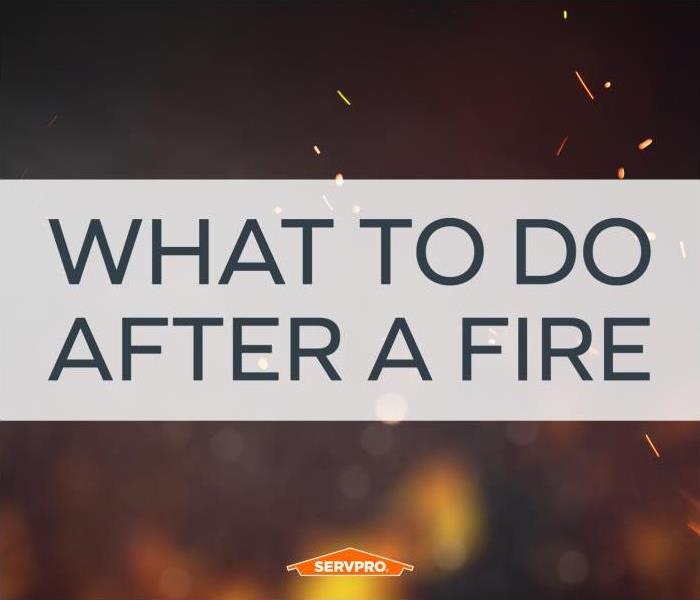 If you’ve suffered a house fire call SERVPRO of St. Charles to help restore your home back to preloss condition.
If you’ve suffered a house fire call SERVPRO of St. Charles to help restore your home back to preloss condition.
After a fire, it can be hard to know what to do next. The actions you take immediately after a fire can affect the restoration of your property.
Your first priority should be to get in touch with a fire damage restoration specialist, such as SERVPRO of St. Charles, to assess the damage and get your property back to its pre-fire condition.
Before entering a building following a fire, make sure that you have the necessary clearance from the Fire Marshal. Also, wear a protective mask to avoid inhaling the smoke. It is best to avoid the scene of the fire, because the more you move around, the more soot can be spread.
If you must enter your home, follow these simple steps:
- Don't go to heavily burned areas as they may be unsafe.
- Do not attempt to clean off smoke and soot residues from surfaces on your own.
- Discard all food items that were exposed, especially open containers.
- Do not use utensils and dishware that were contaminated.
- Do not use computers, TV’s or other electronic devices, as shorts can cause electrocution.
- Take photos of the damage and make a list of damaged items.
- Contact a contractor to board up windows and other open areas.
- Do not make any permanent repairs until the insurance adjuster has seen the damage.
- Keep any receipts for temporary repairs made for reimbursement purposes.
If you’ve suffered a house fire, follow the tips above – and call SERVPRO of St. Charles to help restore your home back to preloss condition. Call us to learn more about the fire damage restoration process.
How to Use a Wood Stove Safely
1/6/2022 (Permalink)
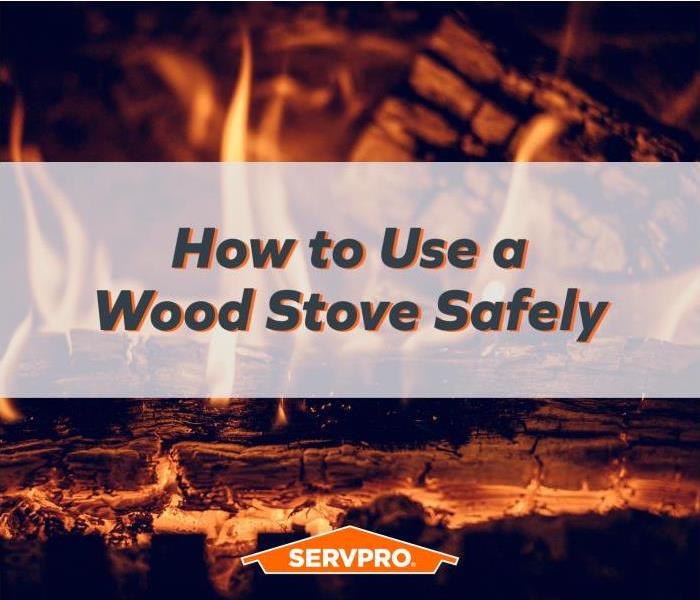 If your home experiences fire due to a wood stove or other source, give SERVPRO of St. Charles City a call. We are here to help.
If your home experiences fire due to a wood stove or other source, give SERVPRO of St. Charles City a call. We are here to help.
During the bitter cold winter months, many homeowners use alternatives to their home heating systems, such as fireplaces, pellet stoves or wood stoves. Each of these heating methods has its benefits and can provide an excellent heat source. If properly installed, maintained, and operated, each can provide years of warmth safely and efficiently. However, using wood stoves also presents risks, such as accidental fires and carbon monoxide poisoning. Proper use of wood stoves can help to significantly reduce the chances of a fire breaking out in your home.
Alternative heat sources do require a certain amount of upkeep for operation and safety. Wood stoves are no exception. So, what can you do to keep your wood stove operating in peak condition? First, let’s look at the type of wood stoves.
Types of Wood Stoves
There are many types and styles of wood stoves suitable for home heating, but most wood stoves can be categorized as either freestanding or a wood stove insert.
A wood stove insert fits into the fireplace opening and vents through the chimney. Some come equipped with a blower to help circulate the heat.
A free-standing wood stove connects to the chimney through a chimney connector. Some may share the flue of an existing or they may vent into a separate chimney built for the stove.
Using the Wood Stove
Be sure to have your chimney inspected to determine if it can be used with a wood stove, because wood stoves generate very hot combustion gases, its chimney must be either masonry or manufactured specifically for burning wood.
If you have a freestanding wood stove, make sure it is located closely to the chimney to limit the length of the flue pipe. When installing, make sure you have easy access to inspect and clean both the stove and chimney connector.
If you have recently moved into a home with a wood burning stove, it’s a good idea to have an inspection performed. This can help make sure it's ready and safe to use, and the inspector may be able to give you some tips on its use.
Never use a freestanding wood stove on a combustible surface such as a wood floor, and it should not be connected to a chimney flue that services another appliance. This could cause a fire or release carbon monoxide.
While wood stoves can provide savings in heating your home, there are some do’s and don’ts to keep in mind to help avoid potential risks, such as burns, fire or carbon monoxide poisoning.
Do:
- Keep children and pets away when you have a fire burning in the stove, as the outer surfaces of the stove and flue pipe are very hot. And keep anything that can burn at least 3 feet away from the stove.
- Make sure you have working carbon monoxide and smoke alarms in your home. Alarms—both fire and carbon monoxide—should be located outside each sleeping area and on every level of the home.
- Regularly remove ashes and properly dispose of them—but do not put them directly into a trash can. Ashes can take several days to cool completely. Instead, place ashes in a covered metal container located at least 10 feet away from buildings or vehicles.
- Have your chimney cleaned and inspected regularly; ideally, at the start of the heating season. It is also a good idea to have it checked halfway through the burning season to check for any creosote buildup.
- Have your wood stove inspected by a professional at least once every year for any wear and tear, especially to the door hinges, the combustion chamber and the connection between the stove and chimney.
- Keep an eye out for any damage or unusual wear and tear, such as buckling, cracks in the glass, open seams or cracks in or corrosion of the metal.
Don’t:
- “Over fire" the stove—in other words, make a larger fire than the stove can handle. Over firing will result in flames entering the flue pipe or chimney, and can cause damage to the stove, the chimney connector or the chimney itself, which could result in a house fire. To avoid over firing, check the instruction manual or with the manufacturer.
- Let ashes build up in the bottom of the stove, as they can interfere with the air flow into the combustion chamber, trap heat and take longer to extinguish.
- Burn anything other than wood in your wood stove. Other combustibles, such as rubber, plastics, garbage or coal, can damage your stove and could also explode or give off toxic, hazardous fumes.
By taking these precautions, you’re ready to use your wood stove during these cold winter months.
If you do experience smoke or fire damage from your wood stove, we are here to help. For professional fire damage remediation, contact SERVPRO of St. Charles City.
Kitchen Fires: 4 Cooking Tips To Reduce Fire Hazards
12/21/2021 (Permalink)
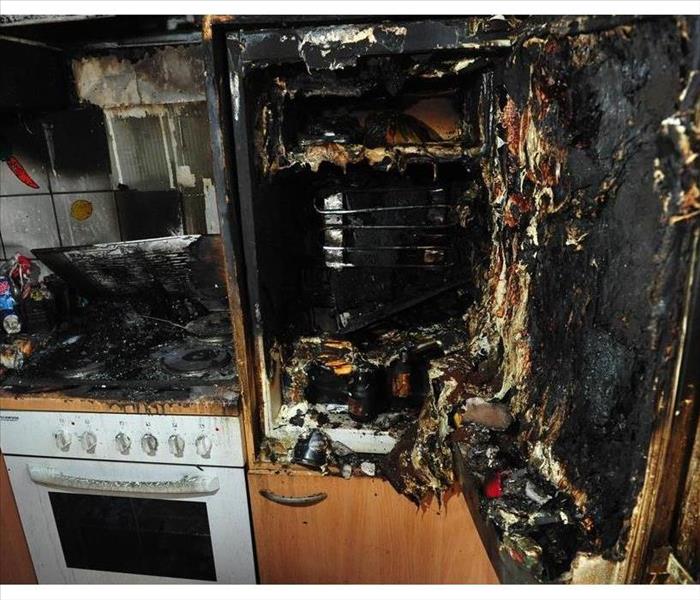 Kitchen fire in O'Fallon, MO.
Kitchen fire in O'Fallon, MO.
Kitchen Fires
While every home should have a smoke detector in the kitchen, there are several other tips for keeping your home and yourself safe when cooking. From rolling up your sleeves and tying back your hair to keeping flammable materials, like paper towel and dish towels, away from the stove, cooking safety is essential when it comes to fire prevention. However, many homeowners can be complacent about the following four risk factors.
1. Appliances
Fire damage is devastating, but the fact that so many fires are caused by faulty or mishandled appliances is shocking. Appliances, if not maintained, are a leading cause of home fires. Be sure to service all your appliances properly. Additionally, unplug small countertop appliances as they draw electricity even when not in use, which can lead to overheating.
2. Too Much Oil or Grease
One of the most overlooked cooking tips is to use less oil and grease. In cooking, a little goes a long way when it comes to these two substances. Using too much of either can lead to grease fires which, if left unattended, can get out of hand quickly. It is important to remember not to throw water on a grease fire because it will only splash the pan and cause the fire to spread, instead use salt or baking soda. For other possible ways to extinguish a grease or oil fire, call a fire remediation specialist in the O'Fallon, MO, area
3. Spills
Another common cause of many kitchen fires is a dirty stove or oven. Always wipe up spills immediately and clean cooktops after use. Leftover grease, oil or food can ignite on the burner, causing a fire. This is another reason why it is essential to keep an eye on food as it cooks because these types of fires require a quick response, or they can spread quickly.
Unfortunately, while the kitchen is the heart of the home, it is also the most likely place for fires to begin. The above tips offer several suggestions for helping you maintain a safe and fire-free home.
Why to Have Electronics Cleaned After a Fire
10/23/2021 (Permalink)
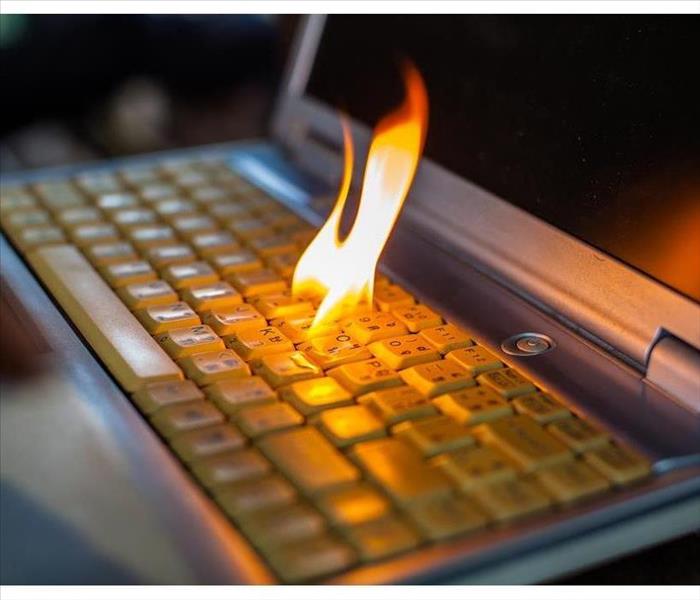 You should call professional expertise to restore your electronics.
You should call professional expertise to restore your electronics.
Why Should You Have Your Electronics Cleaned After a Fire?
If you have experienced a fire, you may not be sure whether electronics are safe to use. Even if a device was not destroyed, intense heat may have warped or otherwise affected delicate internal components. Restoring computers and devices filled with smoke and coated with soot is an important part of fire cleanup. Smoke damage poses several risks to electronics:
• Acidity: The acidity of smoke destroys metals and can cause them to disintegrate. Exposure to corrosive acids in the air may cause devices to fail or behave unpredictably in ways that may be dangerous. Electronics restoration experts can make sure that devices are safe to use and identify which items you should replace.
• Coated Components: Any device found near a fire is likely to require fire cleanup to remove all traces of smoke and soot. The black film which develops over internal components may insulate the heat-producing parts of an electronic device and cause circuits to short. In addition to causing a device to overheat, the chemicals in smoke and soot will adhere to any dust or debris already in a machine and intensify the damage.
• Lost data: Smoke or fire damage may wipe out hard drives, memory, and storage volumes. Even backup drives may be ruined. Electronics restoration professionals can help you retrieve as much data as possible. Keep in mind that the extent of the fire or smoke damage may limit how much can be salvaged.
You may be able to clean the exterior of your device by wiping it down, but you should depend on the professional expertise of a certified fire cleanup service in St. Peters, MO to restore electronics to working order. You should also take pictures or video to document the extent of the damage to your devices in case some of these items are beyond repair and you need to file claims for replacements.
Top 5 Causes of House Fires
7/21/2021 (Permalink)
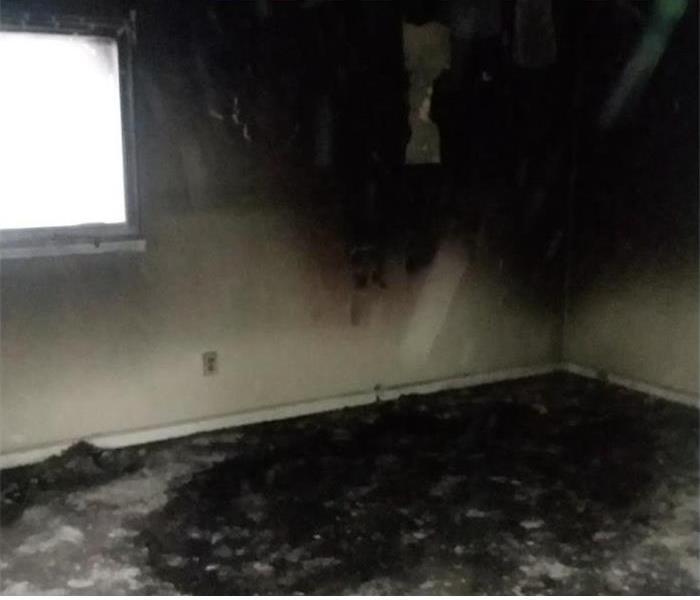 The best way to protect your own safety and reduce fire damage at your home is to know the common causes of home fire and how to prevent them.
The best way to protect your own safety and reduce fire damage at your home is to know the common causes of home fire and how to prevent them.
The Top 5 Reasons for House Fires
Every 86 seconds, fire departments across the United States respond to residential fires. As a homeowner in St. Peters, MO the prospect of a home fire is terrifying. Help prevent fires in your home by knowing the top five fire causes:
1. Cooking
Leaving cooking unattended is the leading fire cause in homes. The risk is increased with frying and attempting to extinguish the blaze without assistance from firefighters. Never leave your home with food cooking in the kitchen. If a fire starts, call 911 before attempting to put out the flames.
2. Smoking
The majority of house fires instigated by smoking involve bedding and upholstery. If you smoke, go outside if possible. Never smoke in bed or near flammable fabrics, especially when tired.
3. Heating
When heating is the reason for a home fire, it is commonly due to space heaters or wood stoves. Reduce your risk by turning off these devices when you are asleep or not at home. Furnace maintenance can help prevent fires due to central heating.
4. Electrical
Failures with electrical equipment or lighting cause 9-13% of residential fires. Check your cords, plugs, outlets and light fixtures for damage and repair or replace as needed.
5. Arson
There is little you can do to prevent a fire that is set intentionally. About half of this type of fire is set by children and adolescents.
The best way to protect your own safety and reduce fire damage at your home in St. Peters,MO is to know the common causes of home fire and how to prevent them. In addition to the above information, keep at least one functioning smoke detector at each level of your home. If possible, install a home sprinkler system. Have and practice an escape plan with your family in case of a fire. After a fire, contact your insurance agent and a fire restoration specialist to begin the process of smoke and fire cleaning.
4 Ways To Keep Your Pet Safe During and After a Home Fire
7/6/2021 (Permalink)
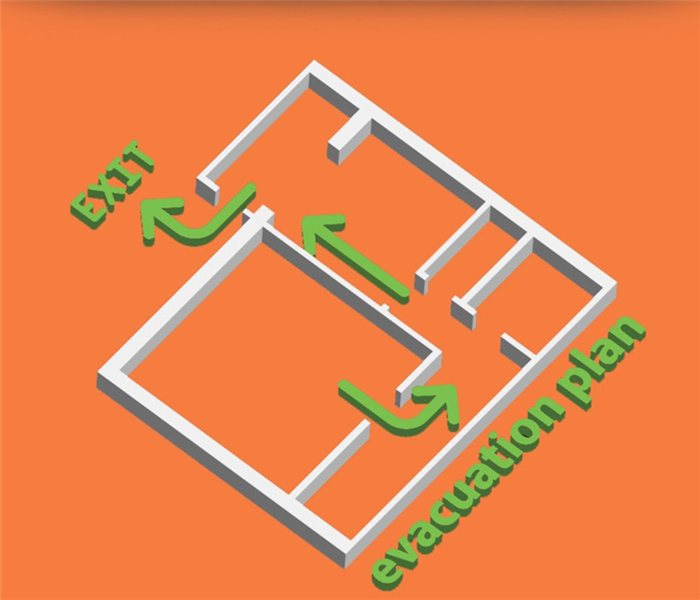 Remember to include your pet in your evacuation plan.
Remember to include your pet in your evacuation plan.
Four Ways to Protect Your Pet During a Fire Emergency
No homeowner wants to go through a home fire. While you can likely replace or repair damaged belongings, you can’t bring pets back to life.
1. Develop a Pet-Evacuation Plan
Like most pet owners, you consider your cats and dogs to be part of the family. As such, you need to include your pets in your evacuation plan. First, find out where your pets prefer to hide. Often, pets seek refuge in these places during emergency situations. Also, if you can do so safely, try to carry pets with you when you evacuate. Don’t forget to collar and leash them, though, as you may be away from the safety of indoor space for hours.
2. Keep Pet Records in an Accessible Place
Fires can be unbelievably destructive. While you may primarily worry about vital and financial documents, you can’t forget about pet records. When you are planning for a fire emergency, store veterinary and other information in a fire-safe box. Then, locate the box in a place where you or a fire-restoration specialist can easily find it.
3. Locate a Safe Spot
As you may know, not all emergency shelters welcome pets. Therefore, your pet preparation must identify a safe spot where your furry friends can stay temporarily after a fire. If your strategy includes staying with family members or friends, confirm that no one has pet allergies.
4. Prevent Pets From Starting Fires
Pets are often responsible for starting fires in St. Peters, MO. While you must have a plan for keeping your pets safe during a fire, you can decrease your chances of having a home fire by keeping open flames away from wagging tails. Additionally, hide wires to discourage your pets from chewing through them.
Ensuring pet safety during a fire requires a bit of preparation. With some effort, though, you can be certain your pets will survive a fire emergency.
4 Things You Should Know About Cleaning Smoke Damage
5/24/2021 (Permalink)
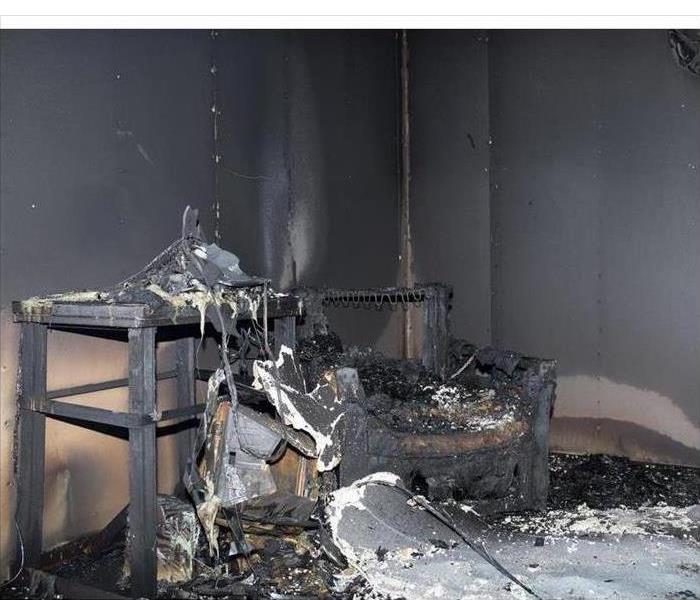 Fire and smoke damage in a St. Peters, MO home.
Fire and smoke damage in a St. Peters, MO home.
Four Things To Keep In Mind After A Fire Strikes
A home fire is one of the most common troubles to befall homeowners and renters. The extent of the fire determines the plan for recovery and restoration. Even a small fire, though, often results in a significant amount of damage to the home and to your belongings. The good news is that a qualified fire mitigation team has the resources to help no matter the situation. The technicians might recommend dry-cleaning of some items, particularly clothes, to get out smoke odors. Here are four things to keep in mind after a fire strikes your home in St. Peters, MO.
1. Content Cleaning Is Important. Many of your belongings will get damaged in a fire. This includes clothes, paintings, furniture, and even computers. A professional company has the equipment and skills needed to restore many items to good shape again, thus saving you money. In general, the technicians will use dry-cleaning for clothes and ultrasonic methods for non-porous items such as televisions and wooden desks and bookcases.
2. Content Storage May Be Needed. If the fire damage to your home is extensive, it is possible items will need to be moved to another area for protection. An orderly move-out and move-in process protect your valuable belongings from additional damage.
3. An Odor Control Technician Will Be Used. Smoke damage is often pervasive and persistent. To get your home clean, a highly-trained technician will use state-of-the-art equipment to remove smoke odors from walls, furniture, and belongings.
4. The Process Is Complex. A number of methods may be employed to get your home back in order again after a fire. The following cleaning methods are available from a professional team: dry-cleaning, immersive cleaning, foam cleaning, abrasive cleaning and spray and wipe options. All of these options allow for a better cleaning of your items as well as the option to restore many items instead of throwing them away.
Protect Your Home After a Fire
3/25/2021 (Permalink)
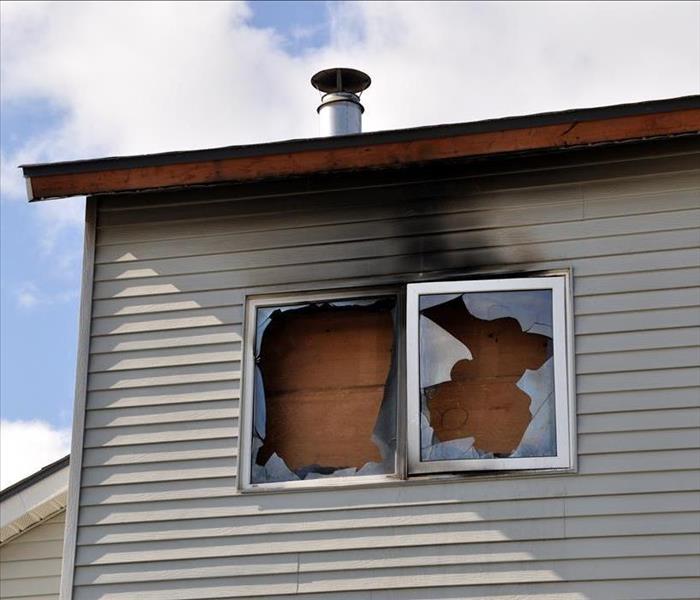 Boarded home after fire damage in St. Peters, MO.
Boarded home after fire damage in St. Peters, MO.
Protect Your Home After a Fire
After your home in St. Peters, MO experiences a fire, the process of returning to normal may seem like a long journey. While a fire damage and restoration specialist will repair, replace and restore it back to its former glory, you still need to protect your home before help arrives. In many cases, windows and other damage happens while extinguishing the flames leave your home exposed. To avoid secondary damage, it is recommended to board up any high-risk areas.
Minimize Risk
While your focus may be on the losses incurred from fire and smoke damage, that isn’t the end of potential risks. An emergency board-up helps in more ways than one.
Insurance Coverage Validity: After experiencing a loss, you want to get the most out of your insurance coverage. The longer you wait to cover existing damage, the higher the chance that additional damage will occur. In many cases, that added damage won’t be covered.
Keep Nature at Bay: Any exposed areas are an instant source of further problems. From wind to water to critters, existing issues may easily become much bigger.
Prevent Property Loss: While the fire may have destroyed or damaged many of your belongings, there is still valuable property inside the home. A boarded-up home helps prevent vandals or thieves from entering and looting.
Reduce Liability: The fire may have created structural damage. If people enter it and get it injured, you will be liable for the injuries.
Services Available
Since every situation is different, so is the type of solution that may be needed. If windows or doors are broken or cracked, a simple board-up will prevent trespassers from entering. If there is roof damage, installing a tarp over the affected area will prevent Mother Nature from wreaking unwanted havoc. In many cases, using both is the best option to get the most coverage possible.
The sooner you board up exposed areas, the better chances you have at getting your home back to “Like it never even happened.”
4 Tips for Safely Using Candles in Your Home
12/23/2020 (Permalink)
 Enjoy using candles in your home and keep your home safe
Enjoy using candles in your home and keep your home safe
Use The Following Tips To Reduce The Chances Of An Emergency
If you enjoy using candles in your Portage Des Sioux, MO, home, then you are certainly not alone. With their varied fragrances and warm light, these items can easily create a pleasant and relaxing atmosphere. On the other hand, they can also cause a candle fire which is anything but soothing. Use the following tips to reduce the chances of an emergency.
1. Keep Candles Away From Flammable Materials
One way to prevent a candle fire is by keeping your candles away from anything that might catch. Don’t burn candles too close to fabric materials, such as bedding or curtains, or paper items like books and magazines. These should be at least a foot or two away from any lit candles. Flammable liquids and aerosols should be even further away.
2. Don’t Leave Candles Unattended
Energetic children or curious pets can easily knock over a candle, so they should always be supervised when candles are in use. However, even if there are no pets or children in your home, you should always extinguish candles when leaving the room. It is best not to leave them burning while you sleep as well.
3. Don’t Burn Candles Too Low
It might seem like a waste not to use every bit of your candle, especially if it’s a pricey scented one, but burning your candles all the way to the end can be a safety hazard. As the flame gets closer to the bottom of the jar, the glass can overheat and shatter, resulting in a candle fire.
4. Use an Alternative
If you enjoy candles but don’t want to worry about the safety risks, you can also find an alternative. Wax melts or diffusers are great for those who are more interested in filling their homes with fragrance. If you prefer the atmosphere created by candlelight, battery-operated candles will fulfill this need without the risk of fire damage.
Fire damage remediation services can perform smoke cleanup and make repairs to your home, but a fire can cause severe damage and loss of property. Keeping an eye on your candles and always using them properly can help keep your home safe.
How To Clean Up Smoke Damage
11/2/2020 (Permalink)
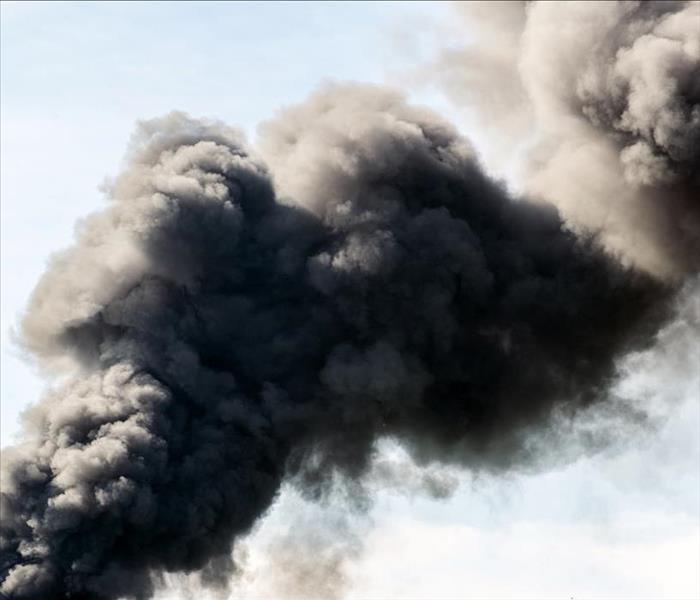 Smoke odor particles can stick to and penetrate nearly every surface
Smoke odor particles can stick to and penetrate nearly every surface
Here Are Some Smoke Cleaning Methods To Look Into
When a fire damages your building in Weldon Spring, MO, smoke odor can linger long after the structural repairs are made. Even if a nearby building caught fire and yours just suffered smoke damage, it can be difficult to fully remove the smell from the air, walls and carpet. Thankfully there are ways to do this, though.
1. Air Out the Building
One of the first steps to cleaning up from smoke damage is to thoroughly air out your building. Open the windows, run fans and get as much fresh air pumping through as possible to remove the smoke odor. Replace your air filters and add other portable air filtration devices throughout the building to scrub the air as well.
2. Clean Every Surface
Smoke odor particles can stick to and penetrate nearly every surface, so one of the first things to do is to clean the whole building. Scrub solid surfaces, wash fabrics, and wipe down walls, being careful to rinse your mops and rags thoroughly as you go to make sure you are getting the smoke particles off. A thermal fogger will be able to get the cleaning supplies into every crack and crevice of the building, allowing you to truly clean the whole structure.
3. If All Else Fails, Ozone
If you've followed the previous steps and there's still an odor, it might be time to ozone the building. This process literally changes the structure of the smoke molecules to neutralize them, which means it's extremely effective. It's best to leave this smoke cleaning method to the experts, though, so call a fire damage remediation company.
Smoke cleaning can be a frustrating process if you don't have the right tools. To help it go smoothly, do your research and call the experts early on in the process, and you'll have your building as good as new in no time.
3 Things You Need to Throw Away After a Fire
9/24/2020 (Permalink)
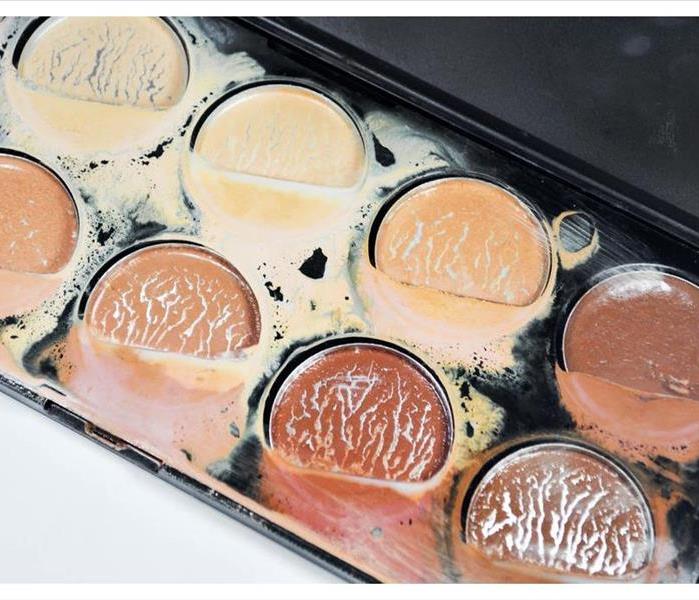 The fire's heat is certainly capable of melting your cosmetics
The fire's heat is certainly capable of melting your cosmetics
Items That Need To Be Discarded After a Fire
Attempting to remediate and recover from fire damage is extremely stressful for any homeowner. One of the first things you need to do upon returning to your property in Portage Des Sioux, MO, is to assess the damage and sort through your belongings to figure out which items you can keep, and which ones you need to throw away. That being said, there are certain items that always need to be discarded following a fire.
1. Burned Medications
It's highly recommended that you discard all of your medications following a fire. The high heat can alter their chemical structures, potentially making them either useless or dangerous to consume. If you want to avoid getting new prescriptions, make sure you check each and every bottle and pill very carefully for signs of heat damage or fire extinguisher residue.
2. Perishable and Non-Perishable Food Items
More likely than not, any food item that has been exposed to fire damage must be thrown away. Non-perishable food items can become contaminated when the fire melts their packaging, permeating the food itself. Perishable food that's inside the refrigerator could potentially be okay if the fridge itself wasn't damaged in the inferno. Assess and determine whether or not to throw away each food item on an individual basis, if this is the case.
3. Damaged or Burned Cosmetics
The fire's heat is certainly capable of melting your cosmetics, effectively changing their chemical structures. Much like your medications, this can make them dangerous to use. Even if they weren't damaged in the fire itself, they may have been contaminated when the fire was extinguished. Check the packaging to see whether it's warped, charred, or melted. Also, check for residue from the fire extinguishers.
Experiencing a home fire is almost just as stressful as attempting to recover from one. Knowing which personal possessions you can keep and which ones you need to throw away can help streamline the process and make it easier for you. Contact fire remediation experts for more information and assistance recovering after a home fire.
Factors in Fire Remediation
7/7/2020 (Permalink)
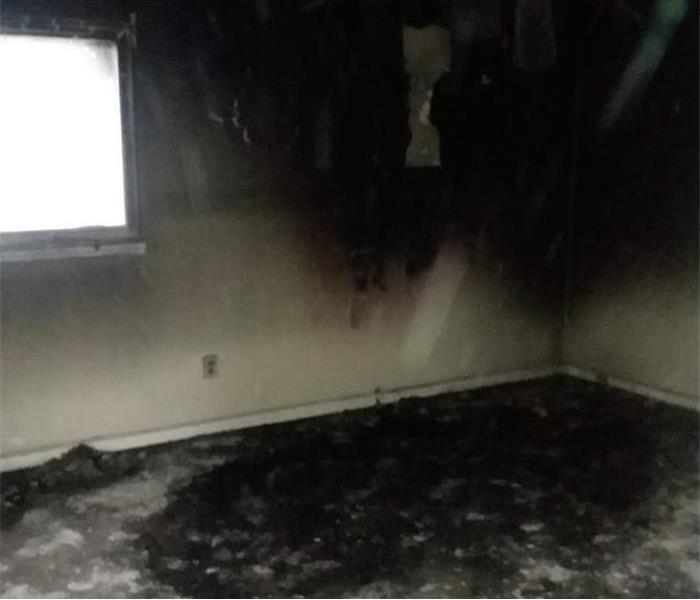 Fire damage in Weldon Springs, MO
Fire damage in Weldon Springs, MO
Fire damage is quite destructive all on its own. If your commercial building in Weldon Spring, MO, is ravaged by a fire, however, it probably also has water damage after the fire is put out. Firefighters use a lot of water to douse the flames and the problems that cause also need to be dealt with during remediation.
Water Mitigation
A fire hose puts out a lot of water, so one of the first things fire restoration specialists have to do is take measures to dry the building out:
- Pump standing water out
- Dry surfaces by increasing air flow
- Bring humidity levels down to normal
It is important to dry your building out to avoid mold growth. Mold patches can start to form in as little as 24 hours after excess moisture becomes present. Taking care of these problems quickly is the best defense your building has against secondary damage.
Fire Mitigation
To mitigate fire damage, technicians have to take several important steps. First, they remove all items in the area affected by the fire. Many of these items may have to be thrown out, but some can be cleaned and salvaged. Second, they tear out all the materials that were destroyed by the fire, including drywall, insulation, carpet, floor pads, and ceiling tiles. Once they have removed all these materials, they start a thorough cleanup. Soot and smoke have to be removed from every surface and crevice, including the many areas of the building otherwise unaffected by the fire. After everything is clean, restoration professionals step in to rebuild the structure and make your building look "Like it never even happened." When there is a fire in your building, it takes a lot of water to put it out and keep it from spreading. You need remediation that tackles both water and fire damage from certified experts who specialize in both.
What To Expect When Rebuilding After a Commercial Fire
5/25/2020 (Permalink)
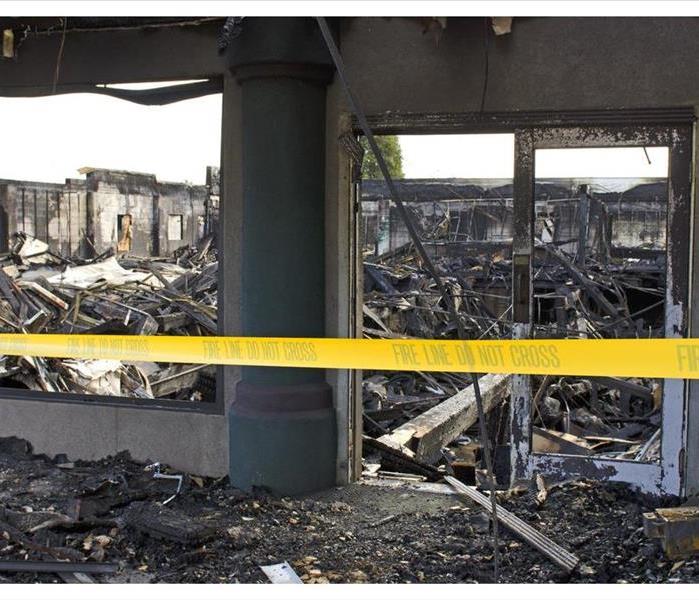 Fire breaks out in a commercial building in St. Charles City
Fire breaks out in a commercial building in St. Charles City
There is a lot to consider when a fire breaks out at your business in St. Charles City, and you are figuring out the process of rebuilding. A good first step is to get an estimate from a reputable fire restoration company. A full-service company will make several considerations when they send contractors to your property to make a bid.
Secondary Damage
When a commercial fire has caused damage to your property, the first job the contractors will do is prevent secondary damage. This will likely start with boarding up the doors, windows, and damaged walls to prevent intrusion, theft, or wandering critters. If there is damage to the roof, then a temporary roof tarp can be put in place to prevent further destruction from weather. If there is concern about theft in the area, then a surveillance system may be installed or a security guard may be dispatched to the property.
Removal Services
Before the restoration process can begin, there needs to be a good cleanup of the property. If the fire department was dispatched to the property, the logical first step is to clean out any remaining water and then estimate the level of water damage. The contractors can then assess how much smoke damage and fire odor is left behind and what procedures are needed to correct the problem. Any unsalvageable debris will most likely be removed, which can help eradicate a lot of the smoke smell.
Restoration of Salvageable Materials
Any items or materials that can be saved will likely be packed up and sent to cleaning facilities in order to remove any smoke or fire damage. The rest of the items can then be moved to storage facilities for the duration of the restoration process.
Calling a fire restoration company to provide an estimate is a smart first step when your business suffers a fire. The contractors can provide a good accounting for how much it will cost to fix your property and work with your insurance company to make sure you have the best experience getting back into business.
Boarding Up After a Fire Is Essential
2/26/2020 (Permalink)
 Don't neglect the board up phase
Don't neglect the board up phase
Boarding Up After a Fire Is Essential
After a fire, your home in O'Fallon, MO, may look and feel like a loss, but it is still a very valuable asset. In fact, the temptation may be to walk away for a bit, trying to remove the emotional pain and physical sight of the destruction. However, it's more important now than ever to stay, working with a fire restoration company to board up the premises, securing it and you from any further harm.
1. Don't Jeopardize Your Coverage
As soon as you wrap up with the fire company, contact your insurance agency and a restoration business. These crews will be essential in the recovery process. As a matter of fact, your insurer may require boarding measures to be taken to prevent other trouble. The restoration team, then, should begin emergency board up. At this time, they assess the building's structure, identifying weak areas, cracks or holes. Vulnerable areas should have boards and tarps placed over them. If not done, it's possible your carrier could deny coverage or make the proceedings more difficult.
2. Avoid Intruders
Exposed houses mean an opportunity for theft or trespassers; therefore, board up in order to lock the place down. Animals could sneak in, taking harbor in your rooms and creating more of a mess for you to handle. In addition, the open windows or doors are a calling card for robberies, asking people to simply try and see what you have left; thus, closing up protects your valuables.
3. Prevent More Harm
Fire damage is costly. Anything that happens afterward could simply increase the bill, so don't allow the environmental factors to ruin your place more. The fire may have ruined shingles, window frames or sideboards, allowing rain and wind to infiltrate. Closing off these areas could help guard from roof collapse, water accumulation, and mold development.
Don't neglect the board up phase. Reinforce your roof, walls, and windows so that you can maintain coverage and avoid major headaches.
Why an Emergency Board Up Is Needed After a Fire
11/22/2019 (Permalink)
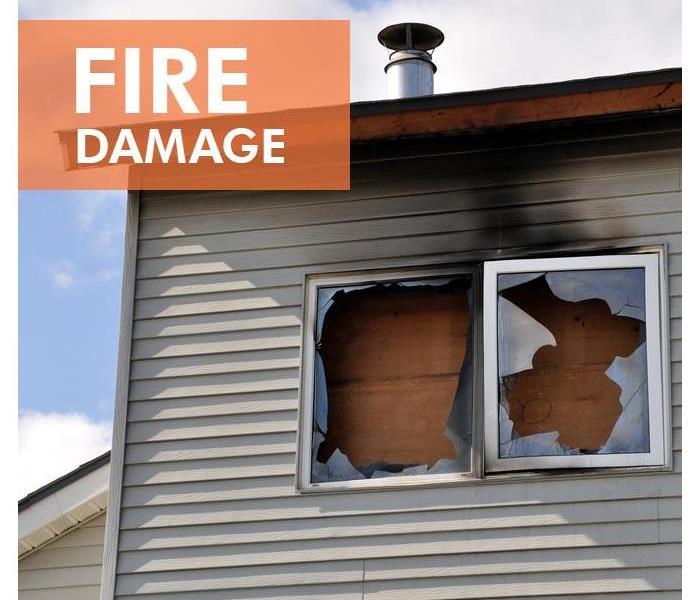 A home needs a board up if doors are broken, windows are shattered and walls are burned away
A home needs a board up if doors are broken, windows are shattered and walls are burned away
Why an Emergency Board Up Is Needed After a Fire
A home fire in Portage Des Sioux,MO, can be a traumatic event and it's possible you won't be thinking your clearest even after the flames have been extinguished. Therefore, it's a good idea to call in a professional fire remediation team to complete an inspection and a damage assessment. Trained technicians can help you avoid mistakes and offer advice that will keep you and your family safe. It's tempting for many people to want to get away from the home and take a break, but it may be beneficial to board up the property before leaving, or to put a tarp over the roof.
Secure Your Home After a Fire
A compromised home exposes property owners to a number of potential liabilities. An emergency board up protects you and your home in the following ways:
- Criminals won't be able to enter your home and steal valuables
- Children won't explore the property and hurt themselves
- Bad weather won't cause additional damage to the home
- Insurance coverage won't be jeopardized because the home was unsecured
A home needs a board up if doors are broken or burned down, windows are shattered and walls are burned away. A tarp might be necessary if the roof is damaged enough to allow in moisture.
Hire a Professional
Serious fire damage requires the work of a professional team. Their services will save you the trouble of having to carry heavy boards onto ladders, risking injury to yourself. They have done the work before and know which materials to use. A quality board up means having the right materials installed in the most secure manner possible. A sub-par job still leaves your home exposed to the elements and could also result in materials falling and harming family members. Recover quickly after a home fire. Get the services you need from a team that is Here to Help in a safe and efficient manner.
Designing Your Home Fire Escape Plan
10/7/2019 (Permalink)
 One of the best things you can do is practice your fire escape plan
One of the best things you can do is practice your fire escape plan
Tips For Designing a Good Escape Plan
In addition to installing smoke alarms, one of the most important fire preparation steps you can take is creating a fire escape plan. A well-planned strategy is critical since you generally have only one to two minutes to safely escape. Here are some tips for designing a good escape plan.
Make a Plan
The hardest part of creating your strategy is starting. Many people fail to plan because they don’t think a home fire will ever happen to them. Even if you never experience the devastating effects of a fire, being prepared for one will give you peace of mind. Here are some suggestions for starting your plan:
- Walk through your home and identify all exits.
- Draw a floor plan marking all possible exits.
- Identify two exits from each room of your home.
- Mark each smoke alarm on the floor plan map.
When making your fire escape plan, make sure infants or those family members with mobility limitations are especially considered. Assign one person to help each individual that has special needs.
Know Important Details
A home fire spreads quickly so it’s critical to know important fire preparation details. First, family members should be familiar with the sound of the smoke alarm. Second, choose an outside meeting place where all family members should congregate immediately following a fire. Third, make sure that your house number is visible from the road so that emergency professionals can find your St. Charles, MO, home.
Practice Your Plan
One of the best things you can do is practice your fire escape plan. Practice should be done at least twice a year and without advance notice. The goal is to see how quickly your family responds to an alarm. Remember to be sensitive to children so that they don’t become frightened easily. The goal is proper education, not fear.
Proper fire preparation includes designing an escape plan. Draw a floor plan of your home and mark all available exits. Educate all family members about your plan. If you ever need assistance after a home fire, there are fire restoration specialists who can help you.
Removing the Smoke Smell From a Home
7/21/2019 (Permalink)
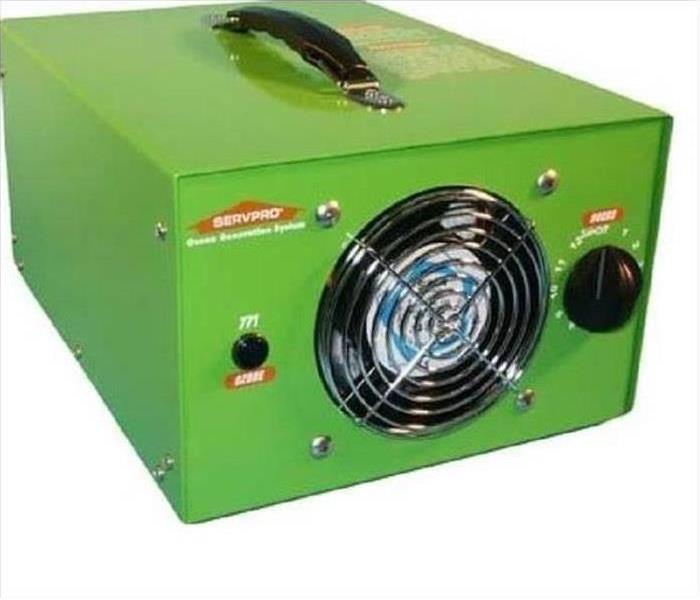 An ozone generator will kill the bacteria and molecules responsibles for the smell
An ozone generator will kill the bacteria and molecules responsibles for the smell
When most people in O'Fallon,MO, think of smoke damage, they associate it with fire cleanup. However, cigarette smoke can also pose a risk to homeowners, as it often gets ingrained in fabrics, carpets and walls. It isn’t an easy smell to eliminate, and professional restoration companies are often the most effective choice.
Why Should You Get Rid of the Smoke Smell?
Most people assume that the harmful effects of cigarette smoke are gone once the cigarette is put out. However, the lingering smell is more than just an unpleasant odor; it actually indicates that there any number of toxins present, including those below:
- Lead
- Cyanide
- Nicotine
- Arsenic
The gases, many of which are carcinogens, are absorbed into walls, furniture or even dust particles. They are then free to be recirculated throughout the air as harmful chemicals for you to breathe. Therefore, it isn’t enough to cover up the smell – you need to have a professional home deodorization.
What Do Professionals Do To Eliminate Smoke?
A professional company will be able to use an ozone generator in order to kill the bacteria and molecules responsible for the smell. They can clean any fabric or carpet to ensure your home is safe for your family and pets. You will need to be away from the area for a short period of time while the ozone dissipates, and then your home will be safe.
Why Not Do It Yourself?
While very effective at home deodorization, ozone needs to be handled properly and by professionals. The entire purpose of cigarette smoke removal is to make your home safe and give you peace of mind. You won’t have that if you’re still wondering whether smoke is present.
In order to keep your lungs healthy, you need to remove smoke damage from your home. It’s important to contact a competent company that can use ozone to kill any chemicals and bacteria that lingers. It is worth the small cost of home deodorization to make it safe and more enjoyable for family members and guests.
Protecting Your Commercial Building After a Fire
6/26/2019 (Permalink)
 The roof can be tarped to prevent wet weather from entering
The roof can be tarped to prevent wet weather from entering
In St. Charles, MO, your business is your lifeline, so it is understandable that following a fire, your desire is to protect it from further destruction. Fire damage can also mean it is a safety hazard, so in the first place you don’t want anyone getting inside and becoming hurt or looting your building – a common problem following damage to a business. Fire cleanup needs to wait until your insurance company is alerted, but there are some things that need to be done right away.
What To Do Immediately After the Fire
The first things you should do if a fire breaks out are to get everyone out of the building as quickly as possible and to call 911 to send firefighters. No attempts should be made to re-enter the building once the fire is out. Even though you may be tempted to go look around, you should notify your insurance company and call for local fire restoration professionals to come and board up and secure the building against the weather and looters. There are several methods that can be used to close openings.
- The roof can be tarped to prevent wet weather from entering
- Sheets of plywood may be fastened over doors and windows
- Lay wooden studs in the tracks of windows and doors to prevent them opening
- Remove valuables to a secure location for storage
Fire damage can make your building more vulnerable to looting and weather damage as openings may be created by segments of the structure falling during a blaze, a firefighters battering ram through a wall or door to get water inside or even exploding chemicals. All of these openings are a potential threat to security and an invitation to a looter. Boarding up is critical to help maintain a secure building.
If you are dealing with fire damage in St. Charles, MO, get the help you need to walk you through the process and stay by your side until the restoration is complete. Fire cleanup and rehabilitation of your commercial building can help make things as good as new.
How To Prepare a Fire Escape Plan
5/22/2019 (Permalink)
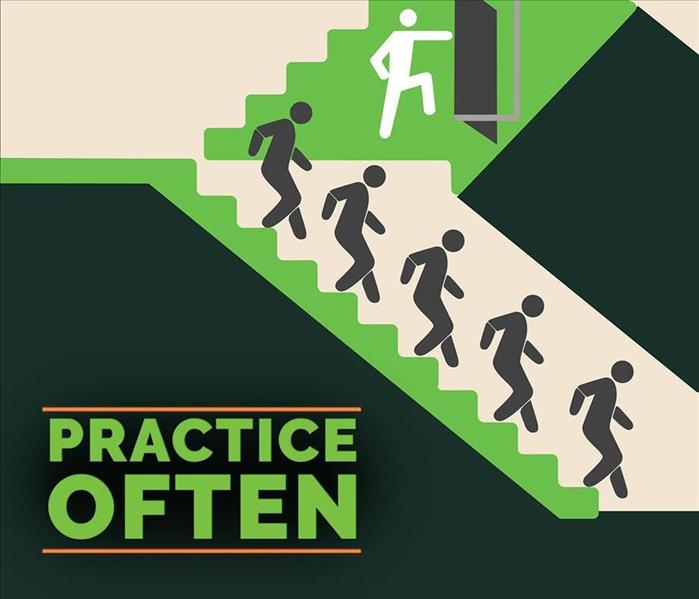 Once you have a plan, it’s often helpful to practice it frequently
Once you have a plan, it’s often helpful to practice it frequently
A Fire Escape Plan Can Help Keep You Safe
Many homes in St. Peters,MO, sustain fire damage every year. Although no one wants to think that a fire could occur in their home, having a fire escape plan can help keep you safe in case a fire starts in your home.
1. Map Out Routes of Escape
One of the first steps in making an emergency escape plan is to map out the best ways to leave your home during a fire. It can be useful to consider how you would escape from any room in your home since you may not be in your bedroom when a fire occurs. Additionally, it’s also often helpful to know multiple ways to escape each room since a fire could cut off access to some parts of your home.
2. Have the Proper Equipment
Ladders, fire blankets, smoke detectors and extinguishers can all be life-saving tools during a fire. When escaping a fire, it can be important to have access to the tools that may be helpful to you. As you make your fire escape plan, it can be helpful to make sure you have the appropriate equipment and tools located in various areas throughout the home in case you are unable to access certain areas in your home due to a fire.
3. Practice Your Plan
Once you have a plan, it’s often helpful to practice it frequently. When you practice, it’s often important to act as you would in a real fire, which means that your focus should be on exiting the home quickly and safely. Don’t bring your belongings with you; in the event of a real fire, fire restoration professionals can restore your home, but it’s important that you get out quickly. Each time you practice, you will likely feel more at ease with your plan.
By having a fire escape plan, you can feel confident in your ability to react to a disaster. In order to create a plan, it’s often helpful to map out routes of escape, have access to important equipment and to frequently practice your emergency escape plan.
Securing Your Building Post-Fire
5/13/2019 (Permalink)
Is your St. Charles City, commercial property suffering after a fire? If you are planning on seeking help from a local fire damage restoration company, you are already on the right track. But you also need to keep your building safe in the meantime. Follow these three steps to make sure looting does not affect your business in the aftermath of a commercial fire.
Identify and Secure Open Spaces
Survey your building very carefully when beginning your fire cleanup efforts. Ensure that all windows, doors and other open spaces are securely locked. Next, make sure that you purchase some sturdy boards that will be sufficiently protective for the type of opening that you are securing. The length of time you expect the boards to be in place should also influence what type of covering you buy.
Research Further Options
While waiting to repair fire damage to your building, you may want to invest in some fencing for added security. This really depends on whether or not you feel that your building is in an area prone to heavy looting, as well as the amount of time you expect your business to be shut down for.
Consider Advanced Security Options
If you feel that your company’s geographical area is highly unsafe or expect you will be closed for a very long time, security services or a high-tech alarm may be the way to go. These options allow your building to be secured when you are not physically available to keep a close watch.
Don’t Get Intimidated
Fire damage is stressful enough without worrying about highly customizable security options. You need to focus on fixing any destruction first and foremost, so if you think complicated security measures are out of the question logistically or financially, stick with basic, reliable boards that will keep your St. Charles City business protected not only from criminal activity, but also the unpredictable natural elements.
4 Ways to Prevent a Fire Disaster
5/10/2019 (Permalink)
 What can I do to prevent a fire?
What can I do to prevent a fire?
Every business may have some level of fire risk. This risk may be higher or lower depending on whether the buildings only have electrical devices and heating equipment or specialized machinery. There are a few fire preparation measures that property owners, employers, and staff can take to prevent fire damage. Take these four disaster preparation measures today to lower your risk.
Keep the Workplace Clean
Clutter can close off evacuation routes and feed a fire. Try to reduce the number of boxes, papers, or other materials that are left lying around a workplace. It is also a good idea to properly dispose of all waste, especially flammable materials.
Maintain Fire Safety Equipment
Regular maintenance can prevent malfunction and reduce fire risks whether a business only has standard office machines or additional machinery. Employees should be made aware of potential overheating dangers and monitor the status of equipment. Have a licensed electrician fix any problems that arise to reduce the risk posed by faulty wiring. Property owners can also regularly test fire suppression systems and ensure that fire extinguishers are frequently inspected and ready for use.
Post Emergency Information
One of the most critical fire preparation steps is to ensure that emergency numbers are posted in convenient locations. Managers and employees should be familiar with the Occupational Safety and Health Administration guidelines for fire safety in the workplace. Property owners may also want to schedule fire drill and tutorials on using extinguishers.
Provide Smoking Areas
Provide designated outdoor smoking areas and make sure that there are safe receptacles for smoldering cigarettes in these areas. Consider a self-extinguishing design that will hide unsightly cigarette butts and reduce the risk of fire.
Taking these fire preparation steps can prevent a workplace disaster. If a structure sustains fire damage, rely on a commercial fire mitigation and restoration service in St. Charles City.
How Do Restoration Experts Clean Electronics After a Fire?
5/8/2019 (Permalink)
Electronics can easily become damaged in the event of a fire at a commercial property. Appliances and devices close to the fire may melt or warp and become unusable. Even electronics that are some distance away may sustain smoke damage that can cause short circuiting and result in an electrical fire. Electronics and computer cleanup experts can take several measures to reduce the risk of fire and restore data that might otherwise be lost.
Assessing Fire Damage
Electronics may become damaged or unpredictable after exposure to fire or smoke. Several common consequences include:
- Warping due to the heat of the fire
- Corrosion due to the acidity of smoke
- Black film coating due to soot
If a device short circuits, it can cause an electrical fire. Do not attempt to turn on electronics before handing them over to cleaning experts. Specialists can check for signs of damage and clean delicate components.
Removing Residual Debris
All build-up should be removed before a device that has been exposed to fire or smoke is tested. Restoration experts may:
- Clean circuits and other metal components
- Wipe off black film
- Vacuum out ash and soot
These methods may increase the likelihood that an electronic device can be repaired. If the device is any type of computer system, these specialists may back up or transfer data.
Backing Up Data
Regardless of whether a device seems to be functioning normally, it is still a good idea to back up data. An electronics cleaning service may offer to:
- Transfer data to a replacement device
- Back up data to a storage medium
- Upload data to secure cloud storage
Rely on the specialized services of a damage mitigation and restoration company after a fire at a commercial property in St. Charles City. These computer cleanup specialists can increase the chances of retaining important data while lowering the risk of an electrical fire.
How To Choose and Use a Fire Extinguisher for Your Home
2/5/2019 (Permalink)
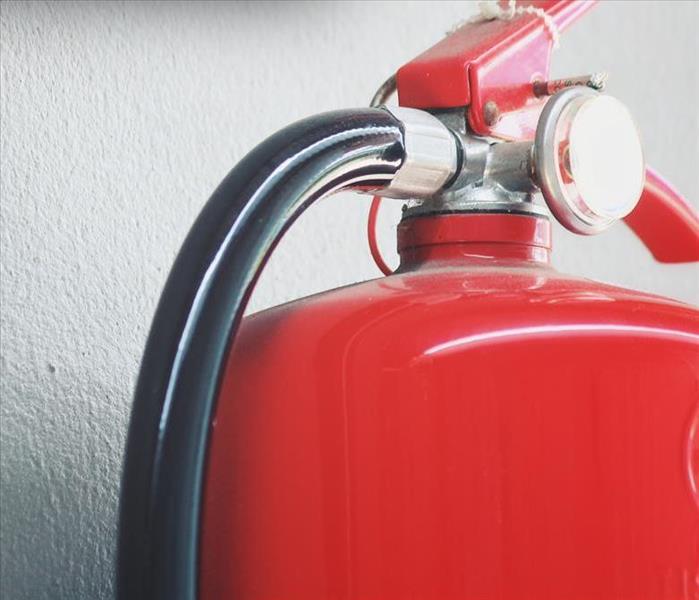 Fire extinguishers are a vital element of home and family safety
Fire extinguishers are a vital element of home and family safety
You hope you never have to face a fire in your home, but taking appropriate precautions is an important way to prepare for emergencies. One of the first things you should do, in addition to installing appropriate fire and smoke alarms, is to put a fire extinguisher in the kitchen,
Types and Classes of Extinguishers
The first step is to identify the appropriate type of extinguisher. There are several options available. These include:
- Water
- Water Mist
- AFFF Foam
- Carbon Dioxide
- ABC Powder
- Wet Chemical
It's important to understand which of these is best for your home. Look at the class designations to make this decision, for example water and foam fire extinguishers are only appropriate for class A fires.
- Class A: solid combustible materials, such as paper, coal, and wood
- Class B: flammable liquids, such as paints, alcohol, and paraffin
- Class C: combustion gases, such as propane, methane, and natural gas
- Class D: flammable metals, such as aluminum, sodium, and potassium
- Class K: combustible cooking materials, such as fats and grease
- Electrical: electrical appliances, such as stereos and fuse boxes
Why the Correct Choice Matters
Using the correct extinguisher is vital. For example, if you were to use a water mist extinguisher on a Class F fire, the water may send drops of burning oil or grease around the room, causing fire damage and injuries to your family members. The extinguishers recommended for homes are Class ABC with higher classification numbers, such as a 3-A:40-B:C unit.
How To Use an Extinguisher
Once you've chosen your extinguisher, follow the PASS sequence to put out flames before fire damage becomes too severe.
- PULL the pin.
- Aim at the base of the fire.
- SQUEEZE the lever or button about the handle.
- SWEEP from side to side.
If you already have extinguishers in your home, check the date. Even if you haven't used the devices, they may lose pressure or effectiveness if they are too old.
Keep Your Home and Family Safe
Fire extinguishers are a vital element of home and family safety. If you're not sure where to keep the safety devices or how many you need for your home, contact fire remediation professionals in St. Charles, MO.





 24/7 Emergency Service
24/7 Emergency Service



























